Madonnina dei Centauri
The history of the sanctuary, the ex-votos, the votive lamp and the meetings of the 1940s
In the previous article written in June 2020, I tried to present to you as concisely as possible an overview of the well-known Italian 'rally-pilgrimage' of the Madonnina dei Centauri (the little Madonna of the Centaurs), from its origins to the present day, as well as its versions organized in turn by the five member nations of the Moto Club International de la Madone des Centaures (MC-MCI), namely Switzerland, Belgium, France, Germany and Spain.
I would like to better completing it from a historical point of view, by providing you with additional information and archives relating to it.
A splendid group photo showing Italian rallyists posing with their machines at a meeting in Turin in the 1930s. Roll your mousewheel to zoom in
I will expand on the history of the Italian sanctuary of Castellazzo Bormida, where this legendary ‘rally-pilgrimage' has taken place every year since 1946. Also the origin of the gathering, its first meetings in the 40s, complemented by images conveying the atmosphere of Italian rallies of yesteryear.
The history of the sanctuary over the centuries
By way of introduction, let's take a tour of the sacred places where the most famous motorcycle 'rally-pilgrimage' on the planet takes place every year, since July 1946.
What exactly do we know about the famous sanctuary?
Through various archives, history reveals to us that in the years 1630-1631, the plague raged in a large part of Northern Italy, bringing desolation and death everywhere and not sparing the region of Alessandria.
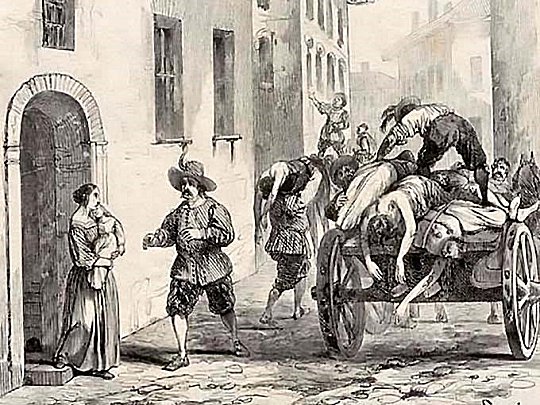
The plague epidemic in Italy of 1629-1631 is said to have cost the lives of a million people, or 25% of the population
Convinced that this was a scourge from God, the desperate people turned to the Capuchin monks whose convent had been located very close to Castellazzo for more than twenty years.
The Capuchin Fathers generously came to their aid, both spiritually and materially, and the Madonna thus became the protector of an entire population in great danger of being totally decimated by the plague.
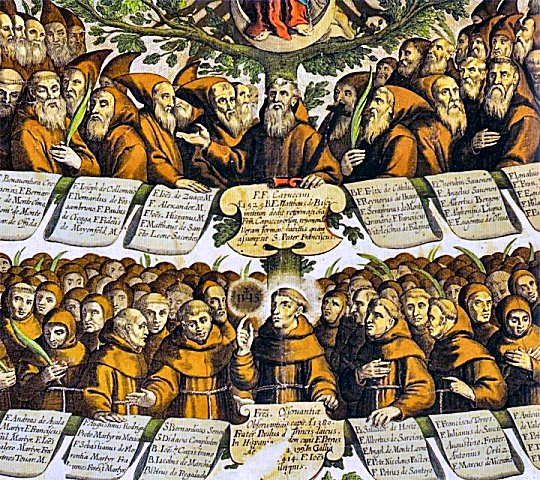
…the desperate people turned to the Capuchin monks...
In 1631, with the epidemic over, in a climate of renewed religious fervor, a notable and pious person from the region by the name of Giovanni Viola had a small country church built at his own expense, on the very spot where the sanctuary is presently located in honor of the Madonna under the title of 'Beata Vergine della Creta e delle Grazie' ('Blessed Virgin of Crete and the Graces'). He placed there, as his most precious jewel, a painting of the Blessed Virgin holding the Child Jesus in her arms.
As for the origin of the painting, the most widespread opinion today is that it derives from the miraculous image of the Madonna of Crea. As can be seen below, the image of the Madonna of Castellazzo is perfectly identical to the image of the Madonna of Crea which was venerated at the time when Giovanni Viola placed it in his small church.
Left: Tableau of the 'Blessed Virgin of Crete and the Graces'; Right: Statue of Our Lady of Crea
Over the years, frequent devasting wars and constant flooding of the Bormida River led to the ruin of the small church. The lack of timely repairs made the building dangerous, so much so that the bishop, during his pastoral visit in 1760, declared the church prohibited and authorized its demolition. The venerated image of the Madonna was then transferred to the parish church of Saint Charles and exhibited in the chapel of Saint Nicholas of Bari.
Despite the demolition of their church, devotion to the Madonna remained alive in the hearts of the faithful who, passing by, never failed to stop to pray, so much so that in 1781, the priest had an oak cross erected at the site of the church. Soon, the cross was replaced by a masonry shrine, on which an image of the Virgin Mary was painted, similar to that preserved in the Saint-Charles church.
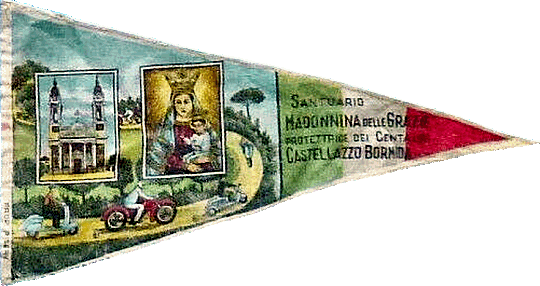
As the number of faithful increased, it became necessary to build a real church, large enough to welcome so many pilgrims: plans were drawn up, land was purchased and no less than 40,000 bricks were supplied.
With great solemnity, on 12 November 1797, the vicar general of the diocese blessed and laid the first stone. But the Napoleonic wars, which affected these regions, forced the work to be interrupted; in fact, the materials and funds reserved for construction were diverted to other public works, such as the preparation of the civic cemetery, imposed by Napoleonic laws.
In 1836, work could resume and, ten years later, the new church was solemnly blessed on 8 November 1846. During a triumphal procession, in which all the authorities, the Capuchin fathers and the brotherhoods participated, the venerated painting of the Holy Virgin of Crete, in exile for 81 years, was brought back and placed in her new grandiose sanctuary. Through continued expansions, the sanctuary acquired its current imposing structure and became the centre of devotion to the Madonna for the entire diocese of Alessandria.
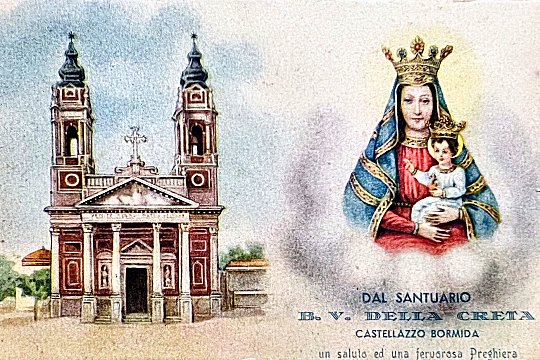
In 1869 the Bishop of Alessandria consecrated the basilica; and in 1880, the Madonna was officially crowned.
On 12 September 1880, Our Lady of Crete was solemnly crowned by the chapter of Saint Peter in the Vatican.
1933 – Creation of the Moto Club of Castellazzo
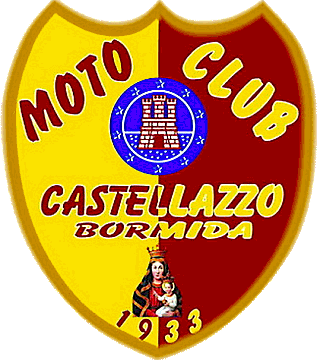
The motorcycle officially entered the religious scene of Castellazo Bormida on the evening of 16 March 1933.
Two residents who were passionate about motorcycles: Dr Marco Re and Giovanni Moccagatta, decided that evening to create a motorcycle club with the aim of going to Rome in May, to take part in the most important Italian motorcycling event of that year: the 'Raduno dei Centauri'.
Two souvenir postcards from the 'political-motorcycling' event of May 1933. The art deco style of the one on the left is remarkably magnificent; the one on the right, advertising for Gilera, shows the dictator Mussolini, Italian Prime Minister from 1922 until his dismissal in 1943
This gathering organized on 24 May 1933 in Rome by the National Fascist Party (PNF) and the Reale Moto Club d'Italia, in which Mussolini himself took part on a motorcycle, brought together nearly 10,000 motorcyclists, military and civilians.
The video below shows an overview of the grandeur of the event:
Note in passing that Benito Mussolini was a real motorcycling enthusiast.
Following the creation of the Moto Club of Rome around 1931, Mussolini joined that club and obtained membership number 1.
His personal motorcycle also bore the number plate 1 ROMA and he proclaimed himself 'Italy's premier motorcyclist'.
A group of participants in the ‘raduno dei Centauri' in Rome; a time when black shirts were particularly fashionable.... Another zoom image
Among the machines he owned, all Italian, was a Bianchi 175 twin-tube Sport Freccia d'Oro.
A great supporter and defender of Italian motorcycling, he not only abolished the compulsory driving license but also considerably helped Italian brands producing economical small-displacement machines by providing state subsidies.
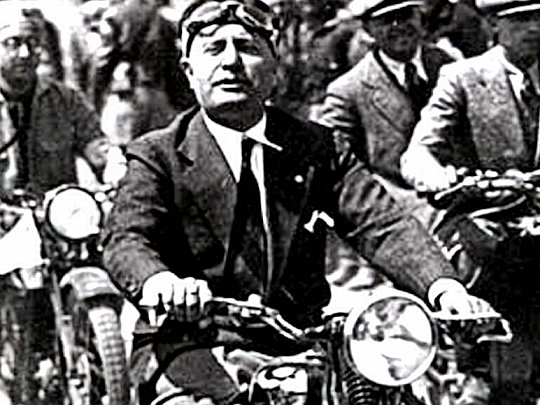
The Duce and the motorcycle have always been closely linked
During the war, he seems to have personally chosen and specified motorcycles for his troops, mainly Guzzis, Bianchis, Gileras and a few Freras.
1934
In 1934, the Moto Club of Castellazzo chose the 'Madonnina della Creta' as its heavenly and protective patroness and began to organize rallies in their region. The start of the Second World War put an end to these gatherings.
A Milan motorcycle club, Gruppo Gilera Milano posing for a souvenir photo during the raduno Genova in 1936
1939
During the year, Dr Marco Re wrote to request the Pope officially designate the 'Madonnina della Creta' as patroness of all motorcyclists.
1943
In August 1943, an article appeared in the press announcing that Dr Marco Re was working on a surprise for the Sanctuary and its dear Madonna.
Two months earlier, on 3 June, he contacted by letter a journalist named Luciano Prati at the 'Gazzetta del Popolo' in Turin, writing the following words:
"Dear Luciano, I have a new idea in mind: that our Sanctuary, which already enjoys a great reputation, further increases its notoriety by becoming the Madonna of Castellazzo, patroness of Italian motorcyclists.
"Motorists have Saint Christopher who is venerated in the famous church of Milan, aviators have Our Lady of Loreto which is that of the famous sanctuary of the same name, motorcyclists will have Our Lady of Castellazzo Bormida.
"You can imagine the prestige and development that our city would acquire: there would be a day of motorcyclists with a great function in the Sanctuary and the blessing of the machines."
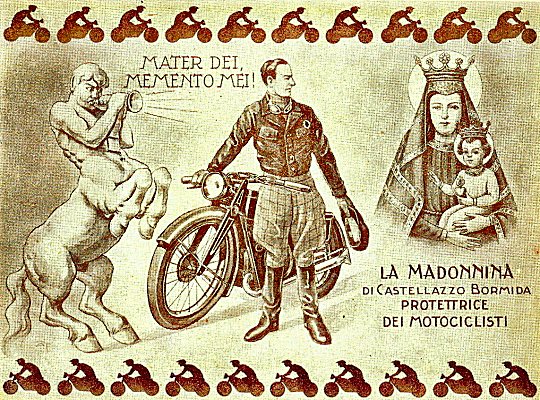
The Madonna dei Centauri, protector of motorcyclists
The journalist's response, of which I quote a significant passage here, was not long in coming:
"I think with certainty that to make faith germinate in a thousand hearts, to the point of leading them on a pilgrimage of love and devotion to the Sanctuary of our Virgin of Crete, it takes either a miracle or the word of the Saints. Neither you nor I are saints. The miracle, on the other hand, can happen, because the divine goodness of our patroness is infinite, and I hope that the miracle worker is a motorcyclist, and then he will be the first to make Her his protector and patron, and others will follow him as you wish and intend."
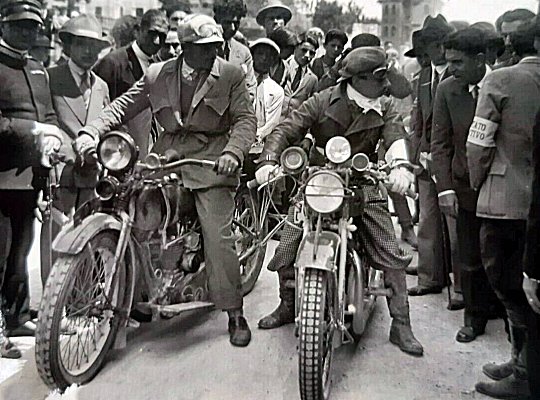
Take a look at what these two Italian Centauri were wearing at the time....there's no denying they had style and class on their machines, even during a rally...
That same year, 1943, while Italy was in the midst of conflict, Italo Luraschi, director of the magazine La Moto, wrote:
"When the war is over and peace reigns again on the land tormented by our homeland, bikers will be able to resume their activity. The Virgin of Motorcyclists (the Madonnina dei Centauri) will inspire their action, will guide their path and protect their success. And once a year, on the occasion of the birthday of our Patron Saint, bikers from all over Italy will gather in Castellazzo to thank their Protector and to implore divine grace. And it will be a spectacle worthy of new times to see the phalanxes of modern horsemen of mechanical civilization, on their steel mounts, approaching the altar with their pennant and repeat the rites of the ancient knights of the Crusades who, upright on their fiery steeds, invoked grace divine before giving battle."
1945
As soon as the war ended, in 1945, Dr Marco Re reiterated his request to the Bishop of Alessandria.
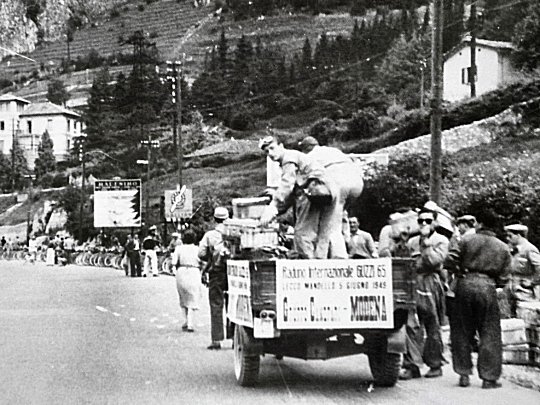
International Moto Guzzi rally in June 1945 in Mandello
1946
In 1946, after years of effort, Dr Marco Re finally saw his dream come true: the first gathering of the Madonna of the Centaurs took place in September. For the record, the first two meetings of 1946 and 1947 are not called 'raduno' (rally) but 'convegno' (convention).
On the occasion of the first international 'convegno' in 1946, in which not only Italian, but also French and Swiss motorcyclists took part, the desire arose for the Madonna of Castellazzo to officially become the 'Queen of the Centaurs'.
1947
In 1947, Pope Pius XII granted this request and, by apostolic letter of 11 February 1947, declared the "Madonnina della Creta primaria Patrona dei motociclisti" (Our Lady of Castellazzo first patroness of motorcyclists).
That same year, on 3 August, the second ‘Convegno Internazionale' took place in which 1,800 rallyists took part.
Souvenir plate (left) and cover of the program (right) of the 2nd ‘Convegno Internazionale' of the Madonnina dei Centauri held on 3 August 1947
Among them, the majority were obviously Italian, but nevertheless five other countries were represented including the Netherlands with the KNMV of S-Gravehague; Belgium with the clubs of Dinant, Schaerbeek, Marche and Mons; Switzerland with the clubs of Montreux, Moutier, Ponte Tresa, the Norton Club of Neuchatel and two clubs of Lausanne; France with the clubs of Moulins, Lyon, Narbonne, Verdun, and Beziers; and the Monaco club.
The French motorcycle club of Moulins won the FMI trophy by finishing in 1st place in the absolute points ranking.
For the record, the motorcycle parade in town could not take place this year due to the exceptional heat (the highest temperature of the year was recorded that day).
Some images from the video below provide a brief overview of the event, including the arrival of motorcyclists at the rally; the Bishop of Alessandria and the honourable Brusasca greeting the motorcyclists; the entrance of waiters with serving dishes:
1949 – The votive lamp, a gift from motorcyclists to their Patron Saint
In 1949, a votive lamp was forged as a gift from motorcyclists to their Patron Saint. On it was engraved the significant dedication: ‘Patronae suae ex toto orbe terrarum fraternitate vincti Centauri nostri' (To their Patroness, of the whole world, united in brotherhood, our Centaurs).
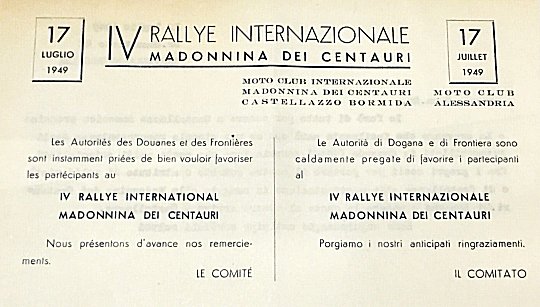
A credential in French and Italian to present to the customs and border authorities so that they can facilitate the motorcyclist's passage across the Franco-Italian border on the occasion of the 1949 Madonnina dei Centauri
On 5 July of the same year, the votive lamp left for Rome aboard a car escorted by a group of motorcyclists and twenty Moto Guzzi workers in overalls and riding on 'Super Alce' models.
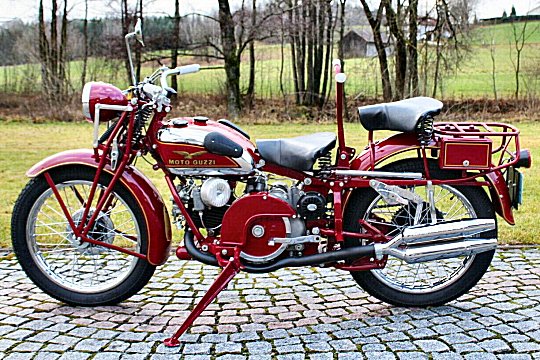
The Moto Guzzi Super Alce, used by the Italian army and carabinieri, was introduced after World War II to replace the very popular Alce, another military motorcycle. The model seen here dates from 1949
This group was welcomed at the Vatican and a small delegation was even received in the papal apartments by Pius XII. The Pope lit the lamp for the first time on the occasion of the upcoming great international gathering of 17 July 1949.
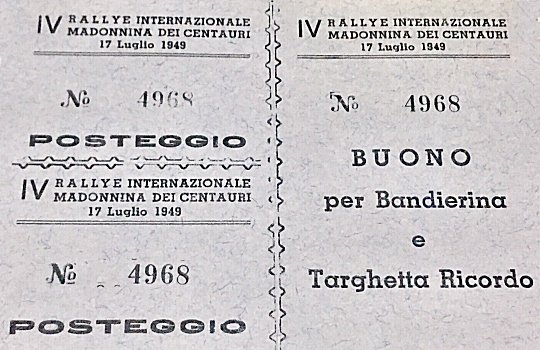
Registration voucher for a pennant and the souvenir medal of the 1949 Madonnina dei Centauri
After a triumphant return, acclaimed by many bikers on the way, the lamp arrived at the sanctuary of Castellazzo Bormida, welcomed by the bishop of the time, to be installed in the sanctuary in front of the Madonna. It burned for many years near the beloved image of the Blessed Virgin of Crete, until it was stolen from the shrine by unknown persons in the 1970s.
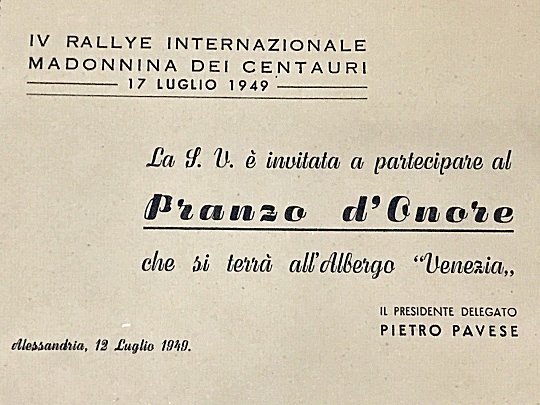
Guest card to attend the honorary lunch held at the 'Venezia' hotel on the occasion of the 1949 Madonnina dei Centauri
History does not say whether the original lamp was finally found. It is likely that it was. Because closer to us in time, more precisely on 7 June 2009, a delegation of thirteen centaurs, riding their historic motorcycles, escorted a Moto Guzzi 'Hercules' with the votive lamp on board for a journey in stages to Rome.
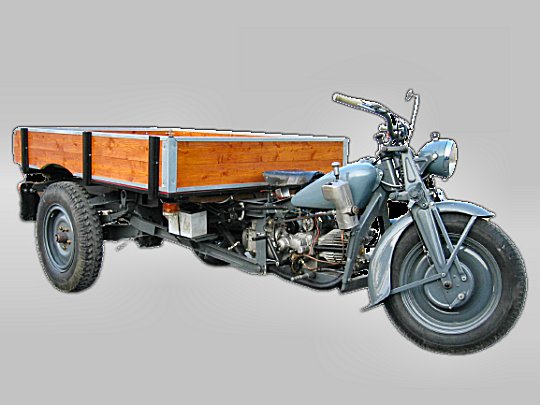
Equipped with a fan-cooled Falcone engine and an electric starter, the Ercole (Hercules) motocarri produced from 1946 had five forward and reverse speeds and an improved bevel gear transmission. A cockpit was available as an option
On the evening of Tuesday 9 June, the votive lamp arrived in Rome where it was expected. On the occasion of the 60th anniversary of the lighting of the votive lamp, Mario Arosio, President of the Moto Guzzi World Club; the Moto d'Epoca group from Castellazzo Bormida MC; the Bressana Bottarone section; and the Moto Club Internazionale Madonnina dei Centauri; participated in the general audience granted by the Holy Father Benedict XVI on 10 June, for the ritual relighting of the votive lamp.
On its return, on the evening of Saturday 13 June, during a solemn celebration in the presence of the bishop, the prefect of Alessandria and the authorities, the votive lamp was transferred to the sanctuary of Castellazzo Bormida, where it will remain forever to illuminate the image of the Blessed Virgin of Crete.
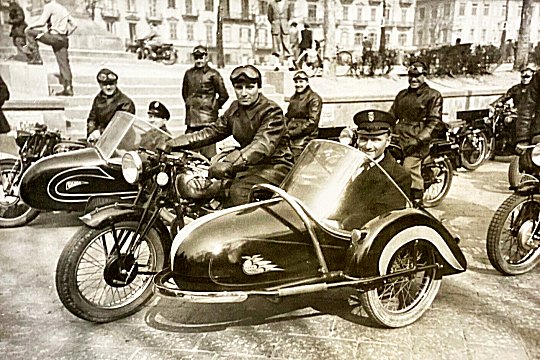
Italian rallyists at the Turin raduno in 1949
Ex-votos in memory of motorcyclists who died in an accident
For almost four centuries, the inhabitants of Castellazzo and many others, have turned to the Holy Virgin of Crete to invoke her protection against all calamities: epidemics, floods, diseases, famines.
Intercessions are invoked in cases of work accidents, war and, increasingly, road accidents. This is evidenced by the ex-votos: votive tablets, for the grace received, which are found in the corridors of the sanctuary leading to the chapel of the rotunda and the presbytery.
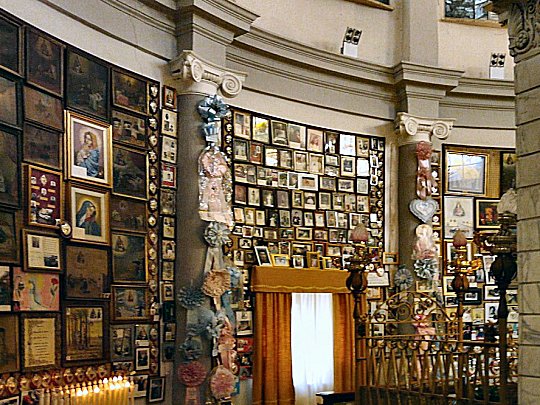
The Rotunda of the sanctuary is lined with a multitude of ex votos
From 1830, ex-votos, witnesses of strong popular devotion, were placed and exhibited in the sanctuary. In the form of paintings, they recount scenes when miracles took place. To date, there are around two thousand of different types, but mostly with a pictorial predominance.
In the drawings of the ex-votos, it is not the miracle that is represented, but rather the moment which precedes it: bedridden patients, work accidents, mainly in agriculture, war scenes in the trenches, etc.
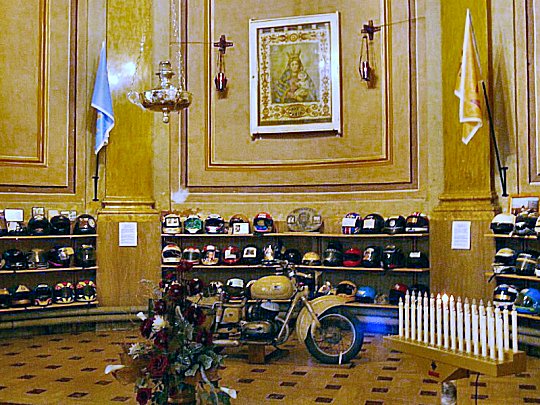
The chapel
From the reconstruction of these events, we can trace a particular history of the village, recalling the customs and traditions of past centuries.
With the evolution of society, carts pulled by oxen or horses, painted like the scene of the accident, were replaced by tractors, then the first cars with external guidance appeared, and finally motorcycles.
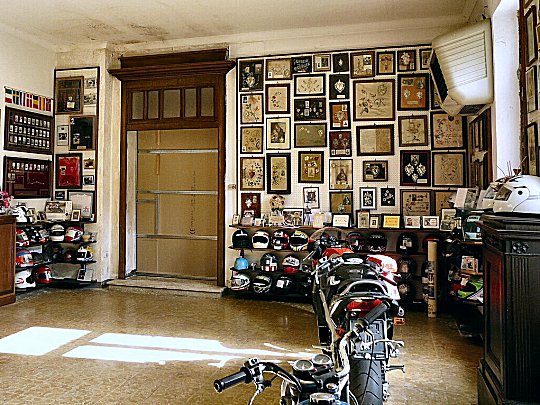
The sacristy
This is how a ‘chapel of the Centaurs' was set up in the basilica of Castellazo Bormida to display the bikers' ex-votos: glasses, helmets, overalls, motorcycle fragments, etc
Alongside all these objects, we also find photographs; all in memory of those who lost their lives in an accident.
- Jean-Francois Helias